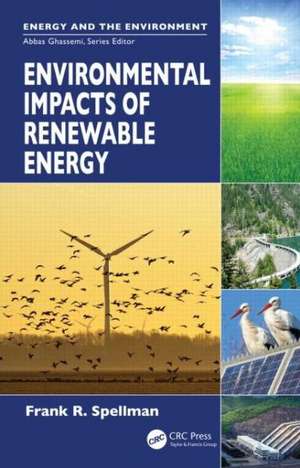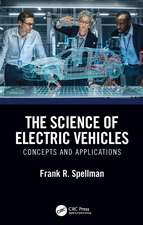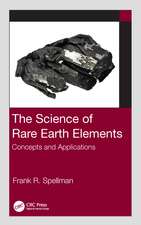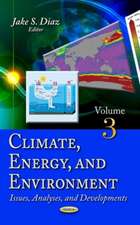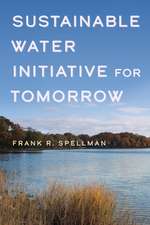Environmental Impacts of Renewable Energy: Energy and the Environment
Autor Frank R. Spellmanen Limba Engleză Hardback – 2 dec 2014
All energy sources affect the environment in which we live. While fossil fuels may essentially do more harm, renewable energy sources can also pose a threat to the environment. Allowing for the various renewable energy sources: solar, wind, hydro, biomass, and geothermal, Environmental Impacts of Renewable Energy examines the environmental effects of all available renewable or alternative sources, as they increasingly play a large part in our energy supply, and provides a counterargument about the benefits of renewable energy. This book discusses both the merits and the physical, mechanical, electrical, and environmental limitations of renewable sources of energy. It discusses the pros and cons of renewable energy, addresses environmental issues and concerns, and determines ways to avoid or minimize these impacts.
This text contains nine chapters reviewing in depth:
- Renewable energy impact on the environment
- Major renewable energy types
- Environmental health, safety, and ecological impacts
- Impact on tribal sacrosanct areas
Preț: 1012.27 lei
Preț vechi: 1234.47 lei
-18% Nou
Puncte Express: 1518
Preț estimativ în valută:
193.69€ • 202.23$ • 160.31£
193.69€ • 202.23$ • 160.31£
Carte tipărită la comandă
Livrare economică 04-18 aprilie
Preluare comenzi: 021 569.72.76
Specificații
ISBN-13: 9781482249460
ISBN-10: 1482249464
Pagini: 478
Ilustrații: 69 black & white illustrations, 32 black & white tables
Dimensiuni: 156 x 234 x 33 mm
Greutate: 0.8 kg
Ediția:1
Editura: CRC Press
Colecția CRC Press
Seria Energy and the Environment
ISBN-10: 1482249464
Pagini: 478
Ilustrații: 69 black & white illustrations, 32 black & white tables
Dimensiuni: 156 x 234 x 33 mm
Greutate: 0.8 kg
Ediția:1
Editura: CRC Press
Colecția CRC Press
Seria Energy and the Environment
Public țintă
Academic and Professional Practice & DevelopmentCuprins
Setting the Stage: The 411 on Energy Basics. Wind Power: Where Eagles Don’t Dare. Solar Energy. Hydropower. Biomass/Bioenergy. Geothermal Energy. Marine and Hydrokinetic Energy. Fuel Cells. Carbon Capture and Sequestration. References and Recommended Reading. Glossary. Appendices. Index.
Notă biografică
Frank R. Spellman, PhD, is a retired assistant professor of environmental health at Old Dominion University, Norfolk, Virginia. The author of more than 90 books covering topics ranging from concentrated animal feeding operations (CAFOs) to all areas of environmental science and occupational health, he has been cited in more than 450 publications, and is a co-author to well-recognized experts in various scientific fields. For example, he is a contributing author of The Engineering Handbook, 2nd ed. Spellman holds a BA in public administration, a BS in business management, an MBA, and both an MS and a PhD in environmental engineering.
Recenzii
"… details the theoretical and practical aspects of the development and use of renewable energy… Spellman offers anecdotal sidelights and highlights hazards and safety measures; e.g., readers are warned that solar panels should never be carried by hand while climbing a ladder. … this book will serve as a resource for engineers, scientists, and indeed anyone interested in environmental studies."
—Choice, September 2015
"This book encompasses all aspects of renewable energy. …Topics covered use real life examples, and start out with a historical perspective. …With renewable energy becoming so important due to rising energy costs, this book provides a go to resource for information for both safety professionals and management."
—Jennifer See, HRSD Safety Manager
"This book makes for very interesting reading and is well worth ownership."
—Energy Sources Part A, May 2016
"… details the theoretical and practical aspects of the development and use of renewable energy… Spellman offers anecdotal sidelights and highlights hazards and safety measures; e.g., readers are warned that solar panels should never be carried by hand while climbing a ladder. … this book will serve as a resource for engineers, scientists, and indeed anyone interested in environmental studies."
—Choice, September 2015
"This book encompasses all aspects of renewable energy. …Topics covered use real life examples, and start out with a historical perspective. …With renewable energy becoming so important due to rising energy costs, this book provides a go to resource for information for both safety professionals and management."
—Jennifer See, HRSD Safety Manager
Although geothermal energy has a proven history, environmental disruption remains a factor, and smaller and more versatile sources such as fuel cells may become widespread. Including basic definitions, tables, and diagrams, this book will serve as a resource for engineers, scientists, and indeed anyone interested in environmental studies.Summing Up: Recommended. All readers.
—R. M. Ferguson, emeritus, Eastern Connecticut State University, CHOICE
"This book makes for very interesting reading and is well worth ownership."
—Energy Sources Part A, May 2016
—Choice, September 2015
"This book encompasses all aspects of renewable energy. …Topics covered use real life examples, and start out with a historical perspective. …With renewable energy becoming so important due to rising energy costs, this book provides a go to resource for information for both safety professionals and management."
—Jennifer See, HRSD Safety Manager
"This book makes for very interesting reading and is well worth ownership."
—Energy Sources Part A, May 2016
"… details the theoretical and practical aspects of the development and use of renewable energy… Spellman offers anecdotal sidelights and highlights hazards and safety measures; e.g., readers are warned that solar panels should never be carried by hand while climbing a ladder. … this book will serve as a resource for engineers, scientists, and indeed anyone interested in environmental studies."
—Choice, September 2015
"This book encompasses all aspects of renewable energy. …Topics covered use real life examples, and start out with a historical perspective. …With renewable energy becoming so important due to rising energy costs, this book provides a go to resource for information for both safety professionals and management."
—Jennifer See, HRSD Safety Manager
Although geothermal energy has a proven history, environmental disruption remains a factor, and smaller and more versatile sources such as fuel cells may become widespread. Including basic definitions, tables, and diagrams, this book will serve as a resource for engineers, scientists, and indeed anyone interested in environmental studies.Summing Up: Recommended. All readers.
—R. M. Ferguson, emeritus, Eastern Connecticut State University, CHOICE
"This book makes for very interesting reading and is well worth ownership."
—Energy Sources Part A, May 2016
Descriere
This book outlines the environmental implications of several renewable energy sources, including solar, wind, hydro, tidal, biomass, and geothermal. Each comes with its own unique benefits as well as downsides. For example, impacts might include sensitive land use concerns, animal habitat disruption/displacement, noise pollution (wind turbines), hazardous materials use for processing (solar panels and fuel cells), sulfur dioxide emissions, land subsidence/sinkholes, and increased risk for earthquakes (geothermal), heavy water use, nitrogen oxides (NOx) emissions, and smog (biomass).
